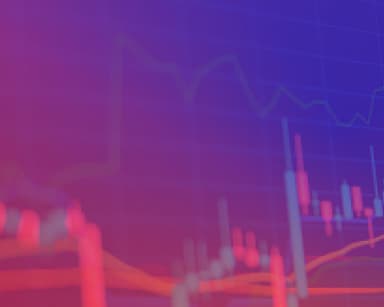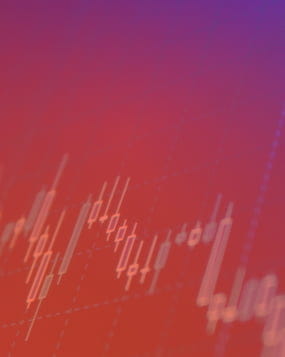
Federal Reserve meeting
How will the next FOMC meeting affect the markets? Find out here – and take your position by trading forex, indices, bonds and more. Open your City Index account to get started.
How to trade the FOMC meeting
Fed announcements can have a significant impact on financial markets, particularly when they reveal imminent – or unexpected – changes to the Federal Funds Rate. Here’s how Fed decisions can affect the markets:
Forex
When the Fed changes rates, USD and other currencies can see significant volatility.
US rate hikes can mean international investors are attracted by higher yields on USD-denominated investments – boosting the value of USD against other currencies.
On the other hand, when the Fed lowers the Federal Funds Rate and interest rates fall, speculators may shy away from the US, weakening USD.
Commodities
When interest rates move higher, the price of commodities tends to decline as it costs more to finance stockpiles, disincentivising supply and changing patterns of demand. Lower interest rates, conversely, may mean higher commodity prices as costs of stockpiling decrease and demand rises against consistent supply.
A rising dollar from a rate hike can also put pressure on commodities, as most commodity markets are priced in USD.
Stocks and indices
In general, low interest rates are beneficial to businesses, enabling them to take advantage of cheap debt to invest in growth. They also make the stock market more popular, as yields from bonds and savings accounts are lower.
However, while sometimes stock indices such as the S&P 500 (US SP 500) initially react bullishly to rate cuts, the news may be overshadowed by other more gloomy fundamentals.
What is the Federal Reserve?
The Federal Reserve is the central bank of the United States, with the mandate to maintain and grow a stable economy via price stability, regulated interest rates and maximum employment. The Fed regulates monetary policy and controls the money supply, with its measures impacting inflation, consumer behaviour and various financial instruments.
The Federal Reserve was created on 23 December 1913 by the United States Congress, with the express intention to deliver a safer, more stable and more flexible financial and monetary system to America.
How does the Federal Reserve work?
The Federal Reserve works using a regionally-distributed assortment of 12 Federal Reserve banks, all governed by the Federal Reserve Board. These banks’ duties include being depositories for commercial bank reserves, lending to other banks, issuing banknotes as circulating currency and administering the deposit accounts of the federal government.
There are 12 Federal Reserve Banks in total, each operating within a different district of the US. These branches serve to oversee regional economic interests, carrying out policies set by Washington by the Fed’s board of governors. Here are the 12 Federal Reserve Banks.
| Boston | Atlanta | New York | Philadelphia |
| Cleveland | Richmond | Chicago | St Louis |
| Minneapolis | Dallas | Kansas City | San Francisco |
What is the FOMC?
The FOMC is the Federal Open Markets Committee, an organisation consisting of 12 members, chaired by Jerome Powell and made up of the Board of Governors and a few of the presidents of the Reserve Banks.
The Federal Reserve makes monetary policy decisions and oversees functional economic development through the FOMC, which holds eight scheduled meetings per year in which economic and financial conditions are reviewed.
What does the FOMC do?
The FOMC sets targets for the Federal Funds Rate at its meetings, which is the interest rate that banks offer each other for overnight loans. To do so, it takes the performance of various economic indicators, such as the Consumer Price Index and GDP, into account.
The FOMC controls the rate by buying and selling government bonds on the open market (known as ‘open market operations'). Buying bonds serves to put money into the economy with the goal of lowering interest rates, while selling bonds lowers monetary supply with the goal of raising interest rates.
The FOMC also monitors the discount rate, or the rate that banks pay to borrow money from the Fed. When this rate is lower, it is more likely the Federal Funds Rate will be lower too.
Who owns the Federal Reserve bank?
The Federal Reserve Bank is owned by both public and private means. While the Board of Governors is a government agency, the banks themselves exist within a private corporation structure, with member banks holding stock and earning dividends.
Latest FOMC news
FOMC meeting dates 2023
January 31 - February 1
March 21-22
May 2-3
June 13-14
July 25-26
September 19-20
October 31 - November 1
December 12-13
Over one million account holders* use us to trade the financial markets. Here's why.
*StoneX retail trading live and demo accounts globally in the last 2 years.
FOMC FAQ
Does the Fed print money?
The Fed makes decisions on money supply, but it doesn’t actually print the money itself. That job falls to the Treasury Department, which prints currency based on the Federal Reserve’s instructions.
Who appoints FOMC members?
The 12 members of the FOMC consist of:
- The seven members of the Fed’s Board of Governors, who are appointed by the president of the United States
- The president of the Federal Reserve Bank of New York
- Four of the remaining 11 presidents of Reserve Banks. They serve one-year terms on a rotating basis
What does FOMC stand for?
FOMC stands for Federal Open Markets Committee. It’s the group that makes policy decisions for the Federal Reserve eight times a year in regular FOMC meetings.
How does the Fed affect the money supply?
The Fed affects the money supply through its management of reserve requirements, which represent the levels of cash that banks must hold relative to customer deposits. The Fed raising banks’ reserve requirements restricts them from lending, lowering the money circulating in the economy. Conversely, lowering the reserve requirements enables banks to loan more, boosting the supply of money in the economy.
If you have more questions visit the FAQ section or start a chat with our support.


